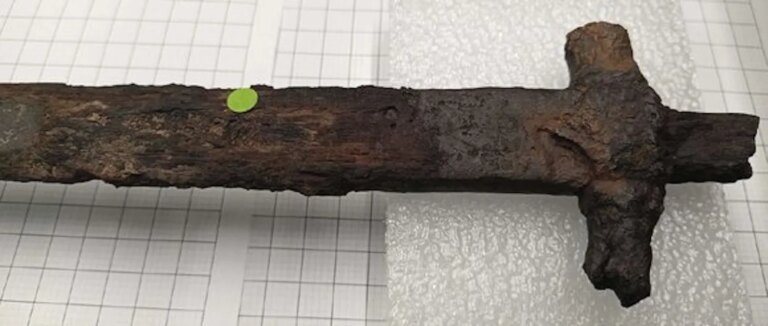The sword isn’t much more than a rusty relic at first glance. Researchers at Germany’s University of Jena (formally Friedrich Schiller University Jena) knew better, but needed a way to peer underneath more than 300 years of corrosion. What they discovered still remains hidden to the naked eye, but is clearly visible thanks to some of the latest advances in computed tomography (CT) scanning technology.
The shortsword was forged in 1558, shortly after Schiller University’s founding and during Germany’s Renaissance era. At the time, only members of the nobility and upper class were permitted to carry such a weapon, also known as a degen. And for many of those members of Germany’s highest social order, the University of Jena was a hub of education and culture. Between 1594 and 1814, its professors, students, and even their families were often buried near the church in the heart of campus called the Collegium Jenense. These crypts frequently included symbolic offerings and personal items—including their trusty shortswords.

The Collegium Jenense was ultimately destroyed during an Allied bombing campaign near the end of World War II, trapping centuries’ worth of historic relics under thousands of pounds of rubble. It would take years of excavations to eventually reveal the buried graves and their artisan-crafted accessories. While one example was recovered largely intact, it still didn’t change the fact that the degen remained covered in rust and grime.
The sword and other artifacts were carefully archived and remained there for decades. In 2018, University of Jena researchers began a project focused on the institution’s earliest years, particularly the Collegiate Quarter’s graves. They suspected they could investigate one of the swords beyond its surface layers, but lacked the technology to try. It would take another four years before the team could partner with INNOVENT, an independent industrial research facility based at the university. Using INNOVENT’s recently acquired X-ray, micro-, and nano-CT scanner, experts could finally see into their mystery weapon.


Once scanned, the team utilized analysis algorithms to generate separate images of the object’s various material layers, then displayed each one using false colors. Green indicated the remains of one side of the sword’s sheath had fused to the blade’s welded steel. Additional scans of the exposed opposite side showed the exposed weapon’s elaborate inlay in red—as well the name “Clemes Stam.”
Stam wasn’t the shortsword’s owner, however. Researchers corroborated historical records to confirm that Stam was actually a blacksmith living in the town of Solingen at the end of the 16th century. Solingen was famed for its swordmaking, with artisans crafting bespoke weapons for European nobility and even the King of Spain. Engraving the maker’s name served as a testament to the owner’s status, as well as the sword’s renowned origins. The team said the sword could only have belonged to either a rector, or a student from a noble family.
“CT doesn’t just capture surface details; it reveals the object’s inner story,” explained project archaeologist Enrico Paust. “In this case, it literally uncovered a name that connects Jena to the European tradition of sword-making.”



